Orinese Phi: Difference between revisions
mNo edit summary |
m (→History: +sign) |
||
| (12 intermediate revisions by the same user not shown) | |||
| Line 1: | Line 1: | ||
{{Infobox currency | {{Infobox currency | ||
| currency_name_in_local = Fī | | currency_name_in_local = Fī Erwaniyesi ([[Oharic]]) | ||
| image_1 = ORP 500 obverse (2018 issue).jpg | | image_1 = ORP 500 obverse (2018 issue).jpg | ||
| image_title_1 = 500 Phi banknote of the 2018 series | | image_title_1 = 500 Phi banknote of the 2018 series | ||
| Line 33: | Line 33: | ||
}} | }} | ||
The '''Orinese Phi''', ([[Oharic]]: ''Fī | The '''Orinese Phi''', ([[Oharic]]: ''Fī Erwaniyesi'', symbol: '''Φ'''; {{wp|ISO 4217|ISO code}}: '''ORP'''; also abbreviated as '''OP''') is the official currency of [[Orioni]] as well as accepted tender in several countries on [[Eurth]]. The [[National Bank of Orioni]] is responsible for issuing notes and coins in the nation's currency. The currency was adopted in 1893 and is subdivided into 100 Phili. One Phi is subdivided into 100 Phili (symbol: 𝞅). Altogether, there are eleven denominations of the Phi, with the smallest being the 1 Phili coin, which is valued at one hundredth of a Phi. Other coins include the 5, 10 and 50 Phili and the 1 and 6 Phi coins. The Orinese Phi is the world's fifth-largest reserve currency on [[Eurth]] in February 2021. | ||
== | == History == | ||
The | The history of the Orinese Phi as a unit of currency has a storied past that spans many centuries. Although the currency in its present form was only introduced in 1893, the roots of Orinese monetary systems can be traced back to ancient times. | ||
Historically, the Orinese began their foray into the realm of monetary systems later than the neighbouring [[Aroman Empire]]. It wasn't until the late 2nd century BCE that they began producing their own distinct round currency. Before this, the concept of a currency as we understand it today was still a burgeoning idea. Drawing parallels with other ancient civilisations, the Orinese primarily used coins as mediums to trade valuable metals and to standardise the value of goods. An indication of the widespread nature of trade is the discovery of [[Meda]]nese perfumes as distant as Aroma, hinting at the early establishment and significance of the [[Pearl Road]] for trade. | |||
[[File:SARMATIA, Olbia. Circa 5th-4th Century BC.jpg|200px|thumb|left|Distinctive Orinese “Dolphin” coin, {{circa}} 1st century CE.]] | |||
Delving deeper into their ancient monetary practices, the earliest forms of Orinese currency were not minted coins in the typical sense. Starting from the 5th century BCE, there's evidence that suggests the Orinese produced unique cast bronze money. Rather than adhering to the conventional shapes of the time—round or square—these coins intriguingly took on the form of leaping dolphins. The decision to adopt the {{wp|ingot}} casting method in this distinctive dolphin form over traditional shapes is believed to have been influenced by religious beliefs. Legends attribute the dolphin shape to sacrificial tokens used in the Temple of [[Zuidhaven|Hierapolis]]. However, these bronze dolphin-shaped ingots, despite their cultural and historical significance, were not practically suited for everyday transactions due to their unwieldy size. Despite their impracticality, their production persisted until 218 BCE. | |||
The | The initial currencies of Orioni were a reflection of the socio-economic conditions of the time, wherein trade and barter played crucial roles. These early currencies served as both a medium of exchange and a representation of wealth, indicating the value of goods and services in the region. Before the adoption of a decimal system, Orinese monetary calculations were intricate, relying on a complex system of weights and measures. This system, while functional, often led to confusion in trade and was not conducive to rapid economic growth. Over the centuries, the need for a standardised and efficient monetary system became apparent. The evolution of the Orinese currency was marked by various stages, from barter systems to the introduction of tangible coinage, and subsequently, the shift towards more intricate designs and materials, culminating in the minted coins that preceded the Phi. | ||
{|class= | [[File:Greek uc phi icon.svg|200px|thumb|right|Phi sign.]] | ||
The transition to the modern Phi in 1893 was a significant milestone in Orioni's monetary history. This change streamlined trade, commerce, and economic planning. The Phi was introduced as a response to the need for a more unified and standardised currency that would facilitate both local and international trade. As the Orioni Empire expanded its territories and influence, the Phi became more than just a domestic currency. It started to gain acceptance in different parts of the empire, solidifying its position as a dominant and reliable currency. This acceptance was instrumental in facilitating trade routes, boosting commerce, and establishing economic ties across the empire. | |||
== Administration == | |||
[[File:National Bank of Orioni.jpg|200px|thumb|left|[[National Bank of Orioni|NBO]] complex in [[O'polis]].]] | |||
The [[National Bank of Orioni]], a central institution in the Orinese financial landscape. It not only dictates, but also precisely oversees all aspects of monetary policy related to the Phi currency. Established as the {{wp|central bank}} of [[Orioni]], it plays a critical role in maintaining financial stability and creating a sustainable economic environment. The bank's responsibilities include regulating other banks within the nation, controlling inflation rates, and managing the country's {{wp|foreign reserves}}. Its approach to monetary policy is characterised by a balanced mix of traditional and innovative strategies, aimed at ensuring the stability and strength of the Phi in the global market. In addition to these responsibilities, the National Bank of Orioni also collaborates closely with various governmental and financial entities to support the nation's economic objectives. The bank's policy decisions are made with a focus on long-term economic prosperity, aligning with Orioni's broader financial goals. | |||
The minting of all [[#Coins|coins]] is managed by the [[Royal Orinese Mint]], an organisation known for its excellence in coin production and design. This mint is responsible for creating coins that are not only functional but also aesthetically pleasing, often reflecting the rich cultural heritage of Orioni. The coins produced by the Royal Orinese Mint are renowned for their intricate designs and advanced security features, making them both secure and attractive to collectors. Similarly, the [[Royal Orinese Banknote Printing Corporation]] is charged with the critical task of printing all [[#Banknotes|banknotes]]. This corporation is at the forefront of banknote technology, incorporating advanced security measures to prevent counterfeiting. Their commitment to innovation is evident in the quality of the banknotes, which are designed to be durable and secure while also showcasing [[History of Orioni|Orioni's history]] and achievements. | |||
Finally, it is important to note that the Orinese Phi is the only acceptable {{wp|legal tender}} for all transactions within the country. This exclusivity underscores the importance of the Phi in Orioni's economy and the trust placed in the institutions responsible for its administration. | |||
== Characteristics == | |||
One Phi is subdivided into 100 Phili. Unlike other countries, there are no denominations of 2, 20, 200, etc. The [[#Coins|1-Phili coin]] is rarely used due to its low value, and some stores may no longer accept it. The [[#Banknotes|Φ1000 bill]] is rarely used because it is often associated with crime and money laundering. Criminals who make a lot of money, especially drug dealers, prefer the large denomination: it is easier to transport Φ1000 notes compared to for example, Φ50 or Φ100 notes. | |||
=== Coins === | |||
The [[Royal Orinese Mint]] manages the minting of all coins. Founded in 1754 under the decree of [[Monarchy of Orioni|Empress]] [[Onozomo II]], the Mint has a storied history in crafting Orioni's coinage. In 2018, a significant redesign of these coins was introduced, primarily to update their aesthetic and security features to reflect contemporary standards. A key feature of this redesign was the standardised depiction of Empress [[Joni I]] across all denominations, celebrating the reigning monarch's influence and stature in Orioni. Each coin, regardless of its value, proudly bears the profile of Empress Joni I, reflecting a deep respect for the monarchy and its enduring presence in Orioni's national identity. This decision to feature Empress Joni I on all coins was both a nod to the historical practice of monarchs' profiles on coinage and a statement of contemporary Orinese unity and pride. The depiction was crafted by renowned sculptor and numismatist Eliora Kestas, who was specially commissioned for this task. Her work on the profile of the Empress was praised for capturing the Empress's poise and dignity, adding a sense of elegance to the everyday use of the currency. | |||
The 2018 series also marked an advancement in coin technology and security. Each coin incorporated new, sophisticated anti-counterfeiting measures, including intricate micro-engravings and a unique holographic feature, subtly integrated into the Empress's profile. Additionally, despite the uniformity in imagery, each denomination was distinguished by its size, weight, and edge design, allowing for easy identification by the public. This aspect of the design considered factors like accessibility and ease of use, particularly for the visually impaired. The 2018 redesign, while focusing on the traditional portrayal of the Empress, also embraced modern minting technologies and accessibility considerations, reflecting Orioni's blend of respect for tradition with a commitment to innovation and inclusivity. The Royal Orinese Mint's dedication to excellence in coin production has solidified the reputation of the Orinese Phi as a currency that perfectly balances aesthetic appeal with practical functionality. | |||
{|class='wikitable' style='background:#fff;text-align:center' | |||
|- | |- | ||
!rowspan= | !rowspan='2'|Image ||rowspan='2'|Value ||rowspan='2' |∅ ||colspan='2'|Description | ||
|- | |- | ||
!Obverse!!Reverse | !Obverse!!Reverse | ||
|- | |- {{Coin-copper-color}} | ||
| align= | | align='center'|[[File:ORP Copper Phili obverse (2018 issue).jpg|100px]] [[File:ORP 1 Phili reverse (2018 issue).jpg|100px]] | ||
| 𝞅1 | | 𝞅1 | ||
| 20 mm | | 20 mm | ||
| Profile of [[Monarchy of Orioni|Empress Joni I]] ||Denomination and year | | Profile of [[Monarchy of Orioni|Empress Joni I]] ||Denomination and year | ||
|- | |- {{Coin-copper-color}} | ||
| align= | | align='center'|[[File:ORP Copper Phili obverse (2018 issue).jpg|110px]] [[File:ORP 5 Phili reverse (2018 issue).jpg|110px]] | ||
| 𝞅5 | | 𝞅5 | ||
| 22 mm | | 22 mm | ||
| Profile of Empress Joni I ||Denomination and year | | Profile of Empress Joni I ||Denomination and year | ||
|- | |- {{Coin-silver-color}} | ||
| align= | | align='center'|[[File:ORP Silver Phili obverse (2018 issue).jpg|120px]] [[File:ORP 10 Phili reverse (2018 issue).jpg|120px]] | ||
| 𝞅10 | | 𝞅10 | ||
| 24 mm | | 24 mm | ||
| Profile of Empress Joni I ||Denomination and year | | Profile of Empress Joni I ||Denomination and year | ||
|- | |- {{Coin-silver-color}} | ||
| align= | | align='center'|[[File:ORP Silver Phili obverse (2018 issue).jpg|130px]] [[File:ORP 50 Phili reverse (2018 issue).jpg|130px]] | ||
| 𝞅50 | | 𝞅50 | ||
| 26 mm | | 26 mm | ||
| Profile of Empress Joni I ||Denomination and year | | Profile of Empress Joni I ||Denomination and year | ||
|- | |- {{Coin-yellow-color}} | ||
| align= | | align='center'|[[File:ORP 1 Phi obverse (2018 issue).jpg|140px]] [[File:ORP 1 Phi reverse (2018 issue).jpg|140px]] | ||
| Φ1 | | Φ1 | ||
| 28 mm | | 28 mm | ||
| Profile of Empress Joni I ||Denomination and year | | Profile of Empress Joni I ||Denomination and year | ||
|- | |- {{Coin-yellow-color}} | ||
| align= | | align='center'|[[File:ORP 5 Phi obverse (2018 issue).jpg|150px]] [[File:ORP 5 Phi reverse (2018 issue).jpg|150px]] | ||
| Φ5 | | Φ5 | ||
| 28 mm | | 28 mm | ||
| Line 84: | Line 108: | ||
|} | |} | ||
===Banknotes=== | === Banknotes === | ||
The [[Royal Orinese Banknote Printing Corporation]] is responsible for the printing of all banknotes. This esteemed institution, established in 1876 under the reign of [[Monarchy of Orioni|Empress]] [[Jomi Nabbérrie]], has a long history of producing Orioni's paper currency, marrying artistry with security. In 2018, a comprehensive redesign of the banknotes was undertaken, signifying a major step in the evolution of the nation's currency. Similar to the coins, each banknote in the new series features the portrait of Empress [[Joni I]], a decision that underscores the continuity and stability of the monarchy. The Empress's portrait is a central design element, symbolising national pride and the revered status of the monarchy in Orioni society. This portrait was created by the acclaimed artist [[Helena Rianor]], whose work is known for its lifelike quality and attention to detail. Her depiction of Empress Joni I has been praised for capturing the Empress’s strength and grace, bringing a personal touch to the nation's currency. | |||
The | The 2018 series of banknotes also introduced several key changes. Notable among these was the inclusion of historic moments and cultural landmarks in Orioni on the reverse side of each denomination. For instance, the Φ50 note showcases the signing of the [[Treaty of Syrica]] in 1834, a pivotal moment in Orioni's diplomatic history, while the Φ100 note features the ancient ruins of the city of Kourma, a [[ANESCO]] World Heritage site. Additionally, the rare Φ100 banknote honoured the famed explorer [[Mihran Azari]], who charted numerous trade routes in the early 19th century. | ||
{| class= | Advanced security features were a major focus in the redesign, with each note incorporating various elements like watermarks, security threads, and colour-shifting ink, enhancing their protection against counterfeiting. Moreover, the redesign aimed at improving the tactile differentiation between denominations, with each note varying in size and incorporating raised printing for easier identification, particularly benefiting the visually impaired. The 2018 redesign of the Orinese banknotes, while maintaining the esteemed portrayal of Empress Joni I, also embraced modernity and technological advancements. The Royal Orinese Banknote Printing Corporation's commitment to blending historical reverence with cutting-edge security and accessibility features has reinforced the Orinese Phi's standing as a currency that not only serves an economic purpose. It also reflects the nation's rich cultural heritage and technological prowess. | ||
!colspan= | |||
{| class='wikitable' style='background:#fff;text-align:center' | |||
!colspan='2'| Image !!rowspan='2'| Value !!rowspan='2'| Year !!rowspan='2'| Dimensions<br />(millimetres) !!rowspan='2' colspan='2'| Main colour | |||
|- | |- | ||
! Obverse !! Reverse | ! Obverse !! Reverse | ||
|- | |- | ||
| style= | | style='text-align:center'| [[File:ORP 10 obverse (2018 issue).jpg|border|120px]] | ||
| style= | | style='text-align:center'| [[File:ORP 10 reverse (2018 issue).jpg|border|120px]] | ||
| Φ10 | | Φ10 | ||
| 2018 | | 2018 | ||
| style= | | style='text-align:center'| 120 × 60 mm | ||
| style= | | style='text-align:center; background:olive'| | ||
| Green | | Green | ||
|- | |- | ||
| style= | | style='text-align:center'| [[File:ORP 50 obverse (2018 issue).jpg|border|130px]] | ||
| style= | | style='text-align:center'| [[File:ORP 50 reverse (2018 issue).jpg|border|130px]] | ||
| Φ50 | | Φ50 | ||
| 2018 | | 2018 | ||
| style= | | style='text-align:center'| 130 × 65 mm | ||
| style= | | style='text-align:center; background:orange'| | ||
| Orange | | Orange | ||
|- | |- | ||
| style= | | style='text-align:center'| [[File:ORP 100 obverse (2018 issue).jpg|border|140px]] | ||
| style= | | style='text-align:center'| [[File:ORP 100 reverse (2018 issue).jpg|border|140px]] | ||
| Φ100 | | Φ100 | ||
| 2018 | | 2018 | ||
| style= | | style='text-align:center'| 140 × 70 mm | ||
| style= | | style='text-align:center; background:blue'| | ||
| Blue | | Blue | ||
|- | |- | ||
| style= | | style='text-align:center'| [[File:ORP 500 obverse (2018 issue).jpg|border|150px]] | ||
| style= | | style='text-align:center'| [[File:ORP 500 reverse (2018 issue).jpg|border|150px]] | ||
| Φ500 | | Φ500 | ||
| 2018 | | 2018 | ||
| style= | | style='text-align:center'| 150 × 75 mm | ||
| style= | | style='text-align:center; background:darkred'| | ||
| Red | | Red | ||
|- | |- | ||
| style= | | style='text-align:center'| [[File:ORP 1000 obverse (2018 issue).jpg|border|160px]] | ||
| style= | | style='text-align:center'| [[File:ORP 500 reverse (2018 issue).jpg|border|160px]] | ||
| Φ1000 | | Φ1000 | ||
| 2018 | | 2018 | ||
| style= | | style='text-align:center'| 160 × 80 mm | ||
| style= | | style='text-align:center; background:grey'| | ||
| Grey | | Grey | ||
|} | |} | ||
{{orioni}} | {{orioni}} | ||
{{eurth}} | {{eurth}} | ||
[[Category: | [[Category:Currencies (Eurth)]] | ||
Latest revision as of 14:41, 29 March 2024
| Orinese Phi | |
|---|---|
| Fī Erwaniyesi (Oharic) | |
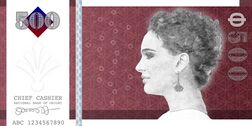 500 Phi banknote of the 2018 series | |
| ISO 4217 | |
| Code | ORP |
| Exponent | 2 |
| Denominations | |
| Subunit | |
| 1/100 | Phili |
| Plural | The language(s) of this currency do(es) not have a morphological plural distinction. |
| Symbol | Φ |
| Phili | 𝞅 |
| Banknotes | |
| Freq. used | Φ10, Φ50, Φ100, Φ500 |
| Rarely used | Φ1000 |
| Coins | |
| Freq. used | 𝞅5, 𝞅10, 𝞅50 Φ1, Φ5 |
| Rarely used | 𝞅1 |
| Demographics | |
| Date of introduction | 1893 |
| Official user(s) | |
| Unofficial user(s) | |
| Issuance | |
| Central bank | National Bank of Orioni |
| Website | www.bank.gov.io |
| Printer | Royal Orinese Banknote Printing Corporation |
| Mint | Royal Orinese Mint |
| Valuation | |
| Inflation | 1.2% (December 2020) |
| Source | National Bank of Orioni |
| Method | CPI |
The Orinese Phi, (Oharic: Fī Erwaniyesi, symbol: Φ; ISO code: ORP; also abbreviated as OP) is the official currency of Orioni as well as accepted tender in several countries on Eurth. The National Bank of Orioni is responsible for issuing notes and coins in the nation's currency. The currency was adopted in 1893 and is subdivided into 100 Phili. One Phi is subdivided into 100 Phili (symbol: 𝞅). Altogether, there are eleven denominations of the Phi, with the smallest being the 1 Phili coin, which is valued at one hundredth of a Phi. Other coins include the 5, 10 and 50 Phili and the 1 and 6 Phi coins. The Orinese Phi is the world's fifth-largest reserve currency on Eurth in February 2021.
History
The history of the Orinese Phi as a unit of currency has a storied past that spans many centuries. Although the currency in its present form was only introduced in 1893, the roots of Orinese monetary systems can be traced back to ancient times.
Historically, the Orinese began their foray into the realm of monetary systems later than the neighbouring Aroman Empire. It wasn't until the late 2nd century BCE that they began producing their own distinct round currency. Before this, the concept of a currency as we understand it today was still a burgeoning idea. Drawing parallels with other ancient civilisations, the Orinese primarily used coins as mediums to trade valuable metals and to standardise the value of goods. An indication of the widespread nature of trade is the discovery of Medanese perfumes as distant as Aroma, hinting at the early establishment and significance of the Pearl Road for trade.
Delving deeper into their ancient monetary practices, the earliest forms of Orinese currency were not minted coins in the typical sense. Starting from the 5th century BCE, there's evidence that suggests the Orinese produced unique cast bronze money. Rather than adhering to the conventional shapes of the time—round or square—these coins intriguingly took on the form of leaping dolphins. The decision to adopt the ingot casting method in this distinctive dolphin form over traditional shapes is believed to have been influenced by religious beliefs. Legends attribute the dolphin shape to sacrificial tokens used in the Temple of Hierapolis. However, these bronze dolphin-shaped ingots, despite their cultural and historical significance, were not practically suited for everyday transactions due to their unwieldy size. Despite their impracticality, their production persisted until 218 BCE.
The initial currencies of Orioni were a reflection of the socio-economic conditions of the time, wherein trade and barter played crucial roles. These early currencies served as both a medium of exchange and a representation of wealth, indicating the value of goods and services in the region. Before the adoption of a decimal system, Orinese monetary calculations were intricate, relying on a complex system of weights and measures. This system, while functional, often led to confusion in trade and was not conducive to rapid economic growth. Over the centuries, the need for a standardised and efficient monetary system became apparent. The evolution of the Orinese currency was marked by various stages, from barter systems to the introduction of tangible coinage, and subsequently, the shift towards more intricate designs and materials, culminating in the minted coins that preceded the Phi.
The transition to the modern Phi in 1893 was a significant milestone in Orioni's monetary history. This change streamlined trade, commerce, and economic planning. The Phi was introduced as a response to the need for a more unified and standardised currency that would facilitate both local and international trade. As the Orioni Empire expanded its territories and influence, the Phi became more than just a domestic currency. It started to gain acceptance in different parts of the empire, solidifying its position as a dominant and reliable currency. This acceptance was instrumental in facilitating trade routes, boosting commerce, and establishing economic ties across the empire.
Administration
The National Bank of Orioni, a central institution in the Orinese financial landscape. It not only dictates, but also precisely oversees all aspects of monetary policy related to the Phi currency. Established as the central bank of Orioni, it plays a critical role in maintaining financial stability and creating a sustainable economic environment. The bank's responsibilities include regulating other banks within the nation, controlling inflation rates, and managing the country's foreign reserves. Its approach to monetary policy is characterised by a balanced mix of traditional and innovative strategies, aimed at ensuring the stability and strength of the Phi in the global market. In addition to these responsibilities, the National Bank of Orioni also collaborates closely with various governmental and financial entities to support the nation's economic objectives. The bank's policy decisions are made with a focus on long-term economic prosperity, aligning with Orioni's broader financial goals.
The minting of all coins is managed by the Royal Orinese Mint, an organisation known for its excellence in coin production and design. This mint is responsible for creating coins that are not only functional but also aesthetically pleasing, often reflecting the rich cultural heritage of Orioni. The coins produced by the Royal Orinese Mint are renowned for their intricate designs and advanced security features, making them both secure and attractive to collectors. Similarly, the Royal Orinese Banknote Printing Corporation is charged with the critical task of printing all banknotes. This corporation is at the forefront of banknote technology, incorporating advanced security measures to prevent counterfeiting. Their commitment to innovation is evident in the quality of the banknotes, which are designed to be durable and secure while also showcasing Orioni's history and achievements.
Finally, it is important to note that the Orinese Phi is the only acceptable legal tender for all transactions within the country. This exclusivity underscores the importance of the Phi in Orioni's economy and the trust placed in the institutions responsible for its administration.
Characteristics
One Phi is subdivided into 100 Phili. Unlike other countries, there are no denominations of 2, 20, 200, etc. The 1-Phili coin is rarely used due to its low value, and some stores may no longer accept it. The Φ1000 bill is rarely used because it is often associated with crime and money laundering. Criminals who make a lot of money, especially drug dealers, prefer the large denomination: it is easier to transport Φ1000 notes compared to for example, Φ50 or Φ100 notes.
Coins
The Royal Orinese Mint manages the minting of all coins. Founded in 1754 under the decree of Empress Onozomo II, the Mint has a storied history in crafting Orioni's coinage. In 2018, a significant redesign of these coins was introduced, primarily to update their aesthetic and security features to reflect contemporary standards. A key feature of this redesign was the standardised depiction of Empress Joni I across all denominations, celebrating the reigning monarch's influence and stature in Orioni. Each coin, regardless of its value, proudly bears the profile of Empress Joni I, reflecting a deep respect for the monarchy and its enduring presence in Orioni's national identity. This decision to feature Empress Joni I on all coins was both a nod to the historical practice of monarchs' profiles on coinage and a statement of contemporary Orinese unity and pride. The depiction was crafted by renowned sculptor and numismatist Eliora Kestas, who was specially commissioned for this task. Her work on the profile of the Empress was praised for capturing the Empress's poise and dignity, adding a sense of elegance to the everyday use of the currency.
The 2018 series also marked an advancement in coin technology and security. Each coin incorporated new, sophisticated anti-counterfeiting measures, including intricate micro-engravings and a unique holographic feature, subtly integrated into the Empress's profile. Additionally, despite the uniformity in imagery, each denomination was distinguished by its size, weight, and edge design, allowing for easy identification by the public. This aspect of the design considered factors like accessibility and ease of use, particularly for the visually impaired. The 2018 redesign, while focusing on the traditional portrayal of the Empress, also embraced modern minting technologies and accessibility considerations, reflecting Orioni's blend of respect for tradition with a commitment to innovation and inclusivity. The Royal Orinese Mint's dedication to excellence in coin production has solidified the reputation of the Orinese Phi as a currency that perfectly balances aesthetic appeal with practical functionality.
| Image | Value | ∅ | Description | |
|---|---|---|---|---|
| Obverse | Reverse | |||
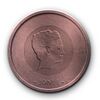 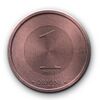
|
𝞅1 | 20 mm | Profile of Empress Joni I | Denomination and year |
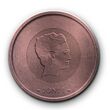 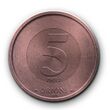
|
𝞅5 | 22 mm | Profile of Empress Joni I | Denomination and year |
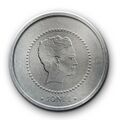 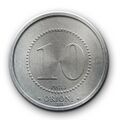
|
𝞅10 | 24 mm | Profile of Empress Joni I | Denomination and year |
 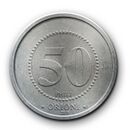
|
𝞅50 | 26 mm | Profile of Empress Joni I | Denomination and year |
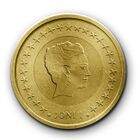 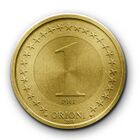
|
Φ1 | 28 mm | Profile of Empress Joni I | Denomination and year |
 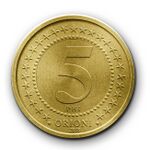
|
Φ5 | 28 mm | Profile of Empress Joni I | Denomination and year |
Banknotes
The Royal Orinese Banknote Printing Corporation is responsible for the printing of all banknotes. This esteemed institution, established in 1876 under the reign of Empress Jomi Nabbérrie, has a long history of producing Orioni's paper currency, marrying artistry with security. In 2018, a comprehensive redesign of the banknotes was undertaken, signifying a major step in the evolution of the nation's currency. Similar to the coins, each banknote in the new series features the portrait of Empress Joni I, a decision that underscores the continuity and stability of the monarchy. The Empress's portrait is a central design element, symbolising national pride and the revered status of the monarchy in Orioni society. This portrait was created by the acclaimed artist Helena Rianor, whose work is known for its lifelike quality and attention to detail. Her depiction of Empress Joni I has been praised for capturing the Empress’s strength and grace, bringing a personal touch to the nation's currency.
The 2018 series of banknotes also introduced several key changes. Notable among these was the inclusion of historic moments and cultural landmarks in Orioni on the reverse side of each denomination. For instance, the Φ50 note showcases the signing of the Treaty of Syrica in 1834, a pivotal moment in Orioni's diplomatic history, while the Φ100 note features the ancient ruins of the city of Kourma, a ANESCO World Heritage site. Additionally, the rare Φ100 banknote honoured the famed explorer Mihran Azari, who charted numerous trade routes in the early 19th century.
Advanced security features were a major focus in the redesign, with each note incorporating various elements like watermarks, security threads, and colour-shifting ink, enhancing their protection against counterfeiting. Moreover, the redesign aimed at improving the tactile differentiation between denominations, with each note varying in size and incorporating raised printing for easier identification, particularly benefiting the visually impaired. The 2018 redesign of the Orinese banknotes, while maintaining the esteemed portrayal of Empress Joni I, also embraced modernity and technological advancements. The Royal Orinese Banknote Printing Corporation's commitment to blending historical reverence with cutting-edge security and accessibility features has reinforced the Orinese Phi's standing as a currency that not only serves an economic purpose. It also reflects the nation's rich cultural heritage and technological prowess.
| Image | Value | Year | Dimensions (millimetres) |
Main colour | ||
|---|---|---|---|---|---|---|
| Obverse | Reverse | |||||

|
File:ORP 10 reverse (2018 issue).jpg | Φ10 | 2018 | 120 × 60 mm | Green | |

|
File:ORP 50 reverse (2018 issue).jpg | Φ50 | 2018 | 130 × 65 mm | Orange | |

|
File:ORP 100 reverse (2018 issue).jpg | Φ100 | 2018 | 140 × 70 mm | Blue | |

|
File:ORP 500 reverse (2018 issue).jpg | Φ500 | 2018 | 150 × 75 mm | Red | |

|
File:ORP 500 reverse (2018 issue).jpg | Φ1000 | 2018 | 160 × 80 mm | Grey | |

